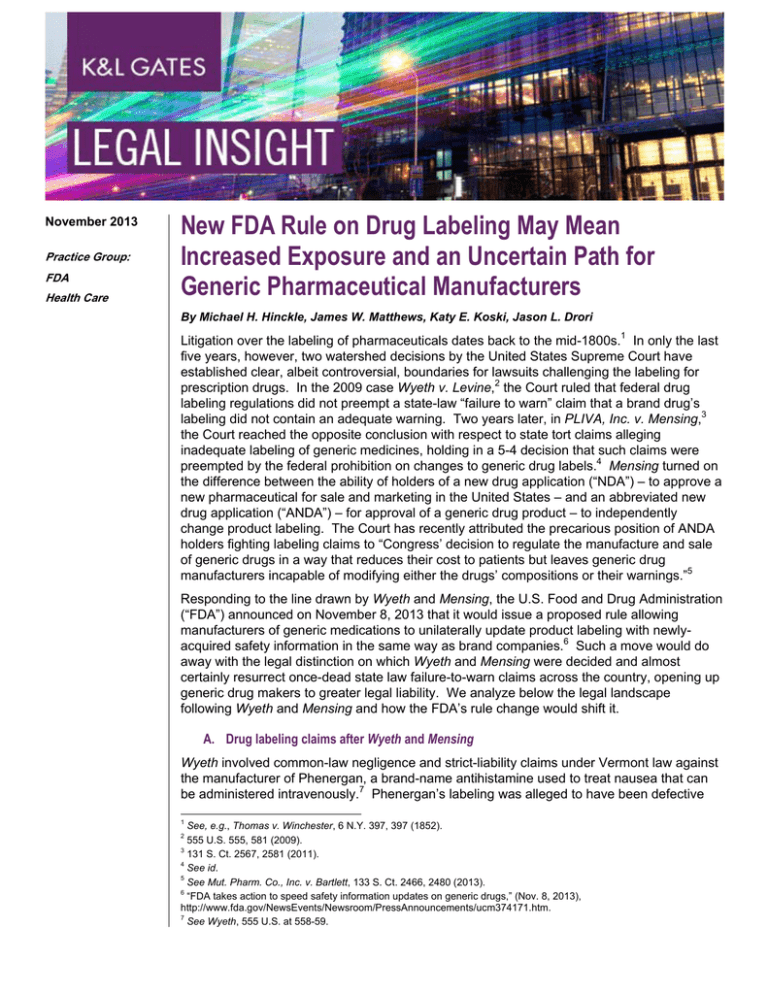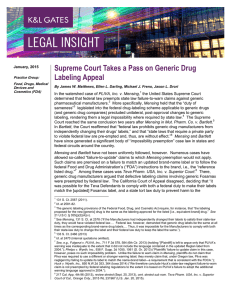
November 2013
Practice Group:
FDA
Health Care
New FDA Rule on Drug Labeling May Mean
Increased Exposure and an Uncertain Path for
Generic Pharmaceutical Manufacturers
By Michael H. Hinckle, James W. Matthews, Katy E. Koski, Jason L. Drori
Litigation over the labeling of pharmaceuticals dates back to the mid-1800s.1 In only the last
five years, however, two watershed decisions by the United States Supreme Court have
established clear, albeit controversial, boundaries for lawsuits challenging the labeling for
prescription drugs. In the 2009 case Wyeth v. Levine,2 the Court ruled that federal drug
labeling regulations did not preempt a state-law “failure to warn” claim that a brand drug’s
labeling did not contain an adequate warning. Two years later, in PLIVA, Inc. v. Mensing,3
the Court reached the opposite conclusion with respect to state tort claims alleging
inadequate labeling of generic medicines, holding in a 5-4 decision that such claims were
preempted by the federal prohibition on changes to generic drug labels.4 Mensing turned on
the difference between the ability of holders of a new drug application (“NDA”) – to approve a
new pharmaceutical for sale and marketing in the United States – and an abbreviated new
drug application (“ANDA”) – for approval of a generic drug product – to independently
change product labeling. The Court has recently attributed the precarious position of ANDA
holders fighting labeling claims to “Congress’ decision to regulate the manufacture and sale
of generic drugs in a way that reduces their cost to patients but leaves generic drug
manufacturers incapable of modifying either the drugs’ compositions or their warnings.”5
Responding to the line drawn by Wyeth and Mensing, the U.S. Food and Drug Administration
(“FDA”) announced on November 8, 2013 that it would issue a proposed rule allowing
manufacturers of generic medications to unilaterally update product labeling with newlyacquired safety information in the same way as brand companies.6 Such a move would do
away with the legal distinction on which Wyeth and Mensing were decided and almost
certainly resurrect once-dead state law failure-to-warn claims across the country, opening up
generic drug makers to greater legal liability. We analyze below the legal landscape
following Wyeth and Mensing and how the FDA’s rule change would shift it.
A. Drug labeling claims after Wyeth and Mensing
Wyeth involved common-law negligence and strict-liability claims under Vermont law against
the manufacturer of Phenergan, a brand-name antihistamine used to treat nausea that can
be administered intravenously.7 Phenergan’s labeling was alleged to have been defective
1
See, e.g., Thomas v. Winchester, 6 N.Y. 397, 397 (1852).
555 U.S. 555, 581 (2009).
3
131 S. Ct. 2567, 2581 (2011).
4
See id.
5
See Mut. Pharm. Co., Inc. v. Bartlett, 133 S. Ct. 2466, 2480 (2013).
6
“FDA takes action to speed safety information updates on generic drugs,” (Nov. 8, 2013),
http://www.fda.gov/NewsEvents/Newsroom/PressAnnouncements/ucm374171.htm.
7
See Wyeth, 555 U.S. at 558-59.
2
New FDA Rule on Drug Labeling May Mean Increased
Exposure and an Uncertain Path for Generic
Pharmaceutical Manufacturers
because it failed to instruct clinicians to use a lower-risk method of intravenous
administration (“IV-drip”) instead of the higher risk method (“IV-push”).8 The Supreme Court
agreed to hear Wyeth to resolve “[t]he question [of] . . . whether the FDA’s drug labeling
judgments preempt state law product liability claims premised on the theory that different
labeling judgments were necessary to make drugs reasonably safe for use.”9
In a 6-3 decision, the Court’s majority found no conflict between drug labeling requirements
imposed under Vermont and federal law because, here, “it was physically possible for Wyeth
to comply with a state-law requirement to provide stronger warnings on Phenergan about the
risks of the IV-push administration method while continuing to market Phenergan in
compliance with federal law.”10 In particular, the FDA’s “changes being effected” (“CBE”)
regulation,11 the Court reasoned, “permitted Wyeth to unilaterally strengthen its [IV-push
administration] warning, and the mere fact that the FDA approved Phenergan’s label does
not establish that it would have prohibited such a change.”12
Mensing involved claims under Minnesota and Louisiana law that the package insert for the
generic drug metoclopramide, a drug commonly used to treat digestive tract problems, failed
to adequately warn that long-term use could cause tardive dyskinesia, a severe neurological
disorder.13 The Court distinguished Mensing from Wyeth based on the different federal drug
labeling duties applicable to brand-name and generic drug manufacturers.14 “A brand-name
manufacturer seeking new drug approval [i.e., an NDA applicant] is responsible for the
accuracy and adequacy of its label. . . . A manufacturer seeking generic drug approval, on
the other hand, [i.e., an ANDA filer] is responsible for ensuring that its warning label is the
same as the brand name’s.”15 Mensing posed the question of whether and to what extent
generic manufacturers could lawfully change their labels following initial FDA approval.16
8
See id. at 560.
See id. at 563 (internal quotations omitted).
10
See id. at 591-92.
11
For most substantive changes to product labeling, a drug application holder is required to seek and obtain FDA
approval for the change. See 21 C.F.R. § 314.70(b). The CBE regulation, however, permits certain labeling changes to
be made effective upon the FDA’s receipt of a supplement containing the new information, including
9
(A) [t]o add or strengthen a contraindication, warning, precaution, or adverse
reaction . . . (B) [t]o add or strengthen a statement about drug abuse,
dependence, psychological effect, or overdosage; (C) [t]o add or strengthen an
instruction about dosage and administration that is intended to increase the safe
use of the drug product; (D) [t]o delete false, misleading, or unsupported
indications for use or claims for effectiveness; or (E) [a]ny labeling change
normally requiring a supplement submission and approval prior to distribution of
the drug product that FDA specifically requests be submitted under this provision.
See 21 C.F.R. § 314.70(c)(6)(iii).
See Wyeth, 555 U.S. at 573.
13
See Mensing, 131 S. Ct. at 2572-73.
14
See id. at 2574. The Court recognized “that the federal statutes and regulations that apply to brand-name drug
manufacturers are meaningfully different than those that apply to generic drug manufacturers,” and that “the special, and
different, regulation of generic drugs [has] allowed the generic drug market to expand, bringing more drugs more quickly
and cheaply to the public.” See id. at 2582.
15
See id. at 2574 (citation omitted). The Federal Drug Price Competition and Patent Term Restoration Act and its
implementing regulations require that abbreviated new drug applications for generic drugs contain “information . . .
insufficient to show that the labeling proposed for the drug is the same as the labeling approved for the [brand] drug
referred to in the application . . . .” See 21 U.S.C. § 355(j)(4)(G); compare 21 C.F.R. § 314.94(a)(8)(iii) (requiring “[a]
statement that the applicant’s proposed labeling . . . is the same as the labeling of the reference listed drug . . .”), with 21
C.F.R. § 314.127(a)(7) (“FDA will refuse to approve an abbreviated application for a new drug . . . for any of the following
12
2
New FDA Rule on Drug Labeling May Mean Increased
Exposure and an Uncertain Path for Generic
Pharmaceutical Manufacturers
The Court held they could not and, accordingly, it decided, “[i]t was not lawful under federal
law for the [generic] [m]anufacturers to do what state law required of them.”17 In other
words, while
state law imposed on the [m]anufacturers a duty to
attach a safer label to their generic metoclopramide[,]
[f]ederal law . . . demanded that generic drug labels
be the same at all times as the corresponding brandname drug labels. Thus, it was impossible for the
[m]anufacturers to comply with both their state-law
duty to change the label and their federal law duty to
keep the label the same.18
Addressing the broad preemptive scope of Mensing, a plurality of the Court stated that
“different federal statutes and regulations may, as here, lead to different pre-emption results,”
but that “it is not this Court’s task to decide whether the statutory scheme established by
Congress is unusual or even bizarre.”19 The Court would not create similar preemption rules
across the dissimilar statutory schemes applicable to brand and generic drug approval but
reminded that “Congress and the FDA retain the authority to change the law and regulations
if they so desire.”20 Enter the FDA.
B. “Leveling the playing field”
“As a result of the decisions in Wyeth v. Levine and Pliva v. Mensing,” the FDA
acknowledges, “an individual can bring a product liability action for failure to warn against an
NDA holder, but generally not an ANDA holder, and thus access to the courts is dependent
on whether an individual is dispensed a brand name or generic drug.”21 The agency claims
Mensing “alters the incentives for generic drug manufacturers to comply with current
requirements to conduct robust postmarketing surveillance, evaluation, and reporting, and to
ensure that the labeling for their drugs is accurate and up-to-date.”22
Discussing the proposed rule last week, the head of the FDA’s Center for Drug Evaluation
and Research, Janet Woodcock, told The New York Times that “with the generic industry
having grown up, most people are taking generic drugs . . . . It’s really time to level the
playing field.”23 To accomplish this, the FDA proposes to “revise and clarify procedures for
[all new drug] application holders to change the labeling of an approved drug or biological
product to reflect certain types of newly acquired information in advance of FDA’s review of
reasons . . . (7) Information submitted in the abbreviated new drug application is insufficient to show that the labeling
proposed for the drug is the same as the labeling approved for the listed drug referred to in the abbreviated new drug
application . . . .”).
16
See Mensing, 131 S. Ct. at 2574.
17
See id. at 2577.
18
See id. at 2578.
19
See id. at 2582 (internal quotations omitted).
20
See id.
21
See 78 Fed. Reg. 67985-02, 67988 (Nov. 13, 2013).
22
See id. at 67988-89.
23
Katie Thomas, Label Updates May Be Allowed for Generics, N.Y. TIMES, Nov. 8, 2013, available at
http://www.nytimes.com/2013/11/09/business/fda-proposes-letting-generic-drug-companies-alter-labels.html?_r=1&.
3
New FDA Rule on Drug Labeling May Mean Increased
Exposure and an Uncertain Path for Generic
Pharmaceutical Manufacturers
the change through a CBE-0 supplement.”24 In particular, the agency’s proposed revisions
to the regulations implementing the rules for post-approval labeling changes under the
Federal Food, Drug, and Cosmetic Act, if adopted, would
(1) enable an ANDA holder to submit a CBE-0 supplement for generic drug labeling that
differs from the labeling of the reference listed drug (“RLD”), e.g., the approved brand
equivalent; and
(2) establish that the labeling criteria in § 314.70(c)(6)(iii) apply equally to NDA and
ANDA holders.25
In the event of a labeling update, the rule would require an ANDA holder to provide notice of
the proposed change to the NDA holder for the RLD at the same time that the supplement to
the ANDA is submitted to the FDA.26 “This proposal would ensure that the NDA holder for
the RLD is promptly advised of the newly acquired information that was considered to
warrant the labeling change proposed for the drug in the CBE-0 supplement.”27 The rule
would not alter the obligation of all NDA and ANDA holders to conduct surveillance,
evaluation, and reporting of postmarketing adverse drug experiences and to propose
revisions to product labeling where appropriate. The above changes, the FDA says, “would
create parity between NDA holders and ANDA holders with respect to submission of CBE-0
supplements for safety-related labeling changes based on newly acquired information” and
improve “communication of important drug safety information to prescribing health care
providers and the public . . . .”28
C. Concluding thoughts: look behind the curtain
The FDA’s proposed rule change seeks to put brand and generic drug manufacturers on
equal footing in order to promote up-to-date drug product labeling with important, newly
acquired safety information. But there clearly is more to the rule than its stated public health
goals.
The rule, first, will have the intended effect of eliminating the shield to liability established by
Mensing for failure to make safety label changes. The FDA advises that “[i]f this proposed
regulatory change is adopted, it may eliminate the preemption of certain failure-to-warn
claims with respect to generic drugs.”29 Reviving these claims inevitably will subject generic
drugs previously “out of bounds” to new labeling suits, begging the question of whether, as a
practical matter, generic labeling would in the future be influenced in some measure by the
looming threat of legal challenges.
Also problematic – for manufacturers, prescribers, and consumers alike – would be
disagreements among multiple drug application holders, be they NDAs or ANDAs, over the
interpretation of postmarketing safety data and whether and when they warrant a label
change. As the FDA points out, “decisions about how to address a safety concern often are
a matter of judgment, about which reasonable persons with relevant expertise may disagree,
24
See 78 Fed. Reg at 67985; see also footnote 11, supra. A “CBE-0 supplement” is a CBE submission that is effective
upon receipt by the FDA, as opposed to a “CBE-30” submission, which becomes effective 30 days after the FDA’s receipt
of the submission. Compare 21 C.F.R. § 314.70(c)(6), with (c)(1).
25
See 78 Fed. Reg. at 67989; see also footnote 11, supra.
26
See 78 Fed. Reg. at 67986.
27
See id.
28
See id. at 67989; 67996.
29
See id. at 67989.
4
New FDA Rule on Drug Labeling May Mean Increased
Exposure and an Uncertain Path for Generic
Pharmaceutical Manufacturers
and this may be reflected in different approaches to proposed labeling changes based on
newly acquired safety information.”30 Unmooring a generic drug’s labeling from that of the
bioequivalent RLD, the FDA concedes, may lead to differences in safety-related labeling.31
This is especially true in a situation where multiple ANDA holders submit CBE-0
supplements with labeling changes that differ from each other and from the RLD.32
Needless to say, confusing or inconsistent labeling for therapeutically equivalent medicines
could pose serious health risks for consumers and sow confusion among drug firms,
pharmacy providers, and health care practitioners. Those risks would be exacerbated if, as
the FDA predicts, “health care practitioners are unlikely to review product labeling for each of
the generic drugs that may be substituted for the prescribed product when making treatment
decisions with their patients based on the balance of potential benefits and risks of the drug
product for that patient.”33 To require or expect otherwise, meanwhile, may frustrate the
longstanding public policy of reducing health care costs by promoting generic substitution by
health care providers. Allowing the labeling for a generic drug and its brand equivalent to
diverge, even temporarily, thus presents potentially serious health and economic
consequences.
A rule permitting ANDA holders to update product labeling irrespective of whether the
revised labeling differs from that of the RLD seems to be at cross-purposes with the “federal
duty of ‘sameness’” recognized in Mensing and by the FDA.34 Perhaps more fundamentally,
it calls into question the judgment by Congress decades ago that proof of bioequivalence
was sufficient for the FDA to approve the manufacture (including labeling) and sale of new
generic drugs. The safety and business concerns raised by the November 13 proposed rule
undoubtedly will generate robust public discussion, making the rule’s final provisions a
mystery well worth monitoring. The public comment period for the proposed rule closes
January 13, 2014.
Authors:
Michael H. Hinckle
James W. Matthews
michael.hinckle@klgates.com
+1.919.466.1115
james.matthews@klgates.com
+1.617.261.3197
Katy E. Koski
Jason L. Drori
katy.koski@klgates.com
+1.617.261.3194
jason.drori@klgates.com
+1.617.951.9143
30
See id. at 67991.
See id. at 67989.
32
See id.
33
See id.
34
See Mensing, 131 S. Ct. at 2574-75 (“The FDA . . . tells us that it interprets its regulations to require that the warning
labels of a brand-name drug and its generic copy must always be the same – thus, generic drug manufacturers have an
ongoing federal duty of ‘sameness.’”).
31
5
New FDA Rule on Drug Labeling May Mean Increased
Exposure and an Uncertain Path for Generic
Pharmaceutical Manufacturers
Anchorage Austin Beijing Berlin Boston Brisbane Brussels Charleston Charlotte Chicago Dallas Doha Dubai Fort Worth Frankfurt
Harrisburg Hong Kong Houston London Los Angeles Melbourne Miami Milan Moscow Newark New York Orange County Palo Alto Paris
Perth Pittsburgh Portland Raleigh Research Triangle Park San Diego San Francisco São Paulo Seattle Seoul Shanghai Singapore Spokane
Sydney Taipei Tokyo Warsaw Washington, D.C. Wilmington
K&L Gates practices out of 48 fully integrated offices located in the United States, Asia, Australia, Europe, the Middle East and South
America and represents leading global corporations, growth and middle-market companies, capital markets participants and
entrepreneurs in every major industry group as well as public sector entities, educational institutions, philanthropic organizations and
individuals. For more information about K&L Gates or its locations, practices and registrations, visit www.klgates.com.
This publication is for informational purposes and does not contain or convey legal advice. The information herein should not be used or relied upon in
regard to any particular facts or circumstances without first consulting a lawyer.
©2013 K&L Gates LLP. All Rights Reserved.
6




